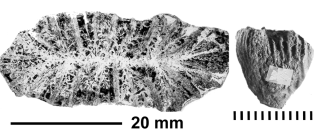
| Intro | | About | | Wiki | | Search traits | | Data explorer | | Literature | | Definitions | | Sources | | Webservices | | Statistics | | Feedback | | Editors | | Log in |
Scleractinia taxon detailsTrochoidomeandra Morycowa, 1971 †
1438076 (urn:lsid:marinespecies.org:taxname:1438076)
accepted
Genus
Trochoidomeandra problematica Morycowa, 1971 † (type by original designation)
marine,
fossil only
Morycowa E. (1971). Hexacorallia et Octocorallia du Crétacé inférieur de Rarau (Carpathes orientales roumaines). <em>Acta Palaeontologica Polonica.</em> 16: 1-149. [details]
Hoeksema, B. W.; Cairns, S. (2025). World List of Scleractinia. Trochoidomeandra Morycowa, 1971 †. Accessed at: https://www.marinespecies.org/scleractinia/aphia.php?p=taxdetails&id=1438076 on 2025-06-05
Date action by
original description
Morycowa E. (1971). Hexacorallia et Octocorallia du Crétacé inférieur de Rarau (Carpathes orientales roumaines). <em>Acta Palaeontologica Polonica.</em> 16: 1-149. [details]
basis of record Löser H. (2013). Critical review of the Trochoidomeandridae family (Scleractinia; Cretaceous) and the genera Felixigyra, Rhipidomeandra, Trochoidomeandra, and Wellsimeandra. <em>Palaeodiversity.</em> 6: 9–21. [details]  Present Present  Inaccurate Inaccurate  Introduced: alien Introduced: alien  Containing type locality Containing type locality
From editor or global species database
Diagnosis Solitary (?colonial), flabellate. Lateral and upper surfaces strongly ribbed. Costosepta thick, compact, with strong outgrowths laterally. Columella absent. Wall septoparathecal. Endothecal dissepiments vesicular. [details]Remark Morycowa (1971, p. 130) described the genus Trochoidomeandra as a colonial coral with radially arranged collines. As later pointed out by Turnšek (in Turnšek and Mihajlovic, 1981, p. 26) the collines entirely correspond to septa in solitary corals. In addition, she recognized the close relation of Trochoidomeandra with the rhipidogyrid genera Psammogyra and Rhipidogyra, especially in reference to the occurrence of thick septa, well-developed lateral ornamentation of septa, and microstructure. Based on the different type of septal ornamentation (long and distinctly laterally outgrowing), she created the new family Trochoidomeandridae. [details] |

